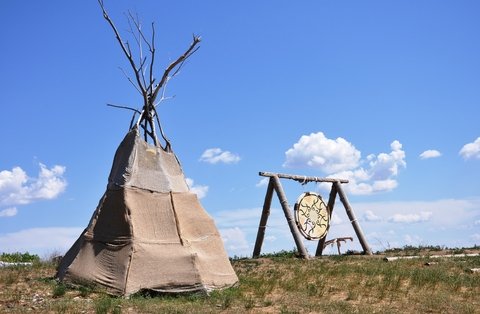
Before I got really serious about primitive skills and the idea of utilizing the whole animal, I realize how wasteful I used to be. But the truth is that most hunters don’t have the time or the need for things like hides, bones and even brains. Another thing many hunters don’t realize is that there are people all over who will actually pay for these items. I was amazed at how many ads I found for people looking for hides and various animal parts. Just something to think about.
As I got deeper into primitive skills, I realized that my thinking about taking a life changed drastically. Not only do I have more reverence for what I kill, I have actually deepened my hunting experience. This deepening has led to more success because I am able to connect more with nature and my primal hunter/gatherer self. Native American hunters knew this secret and we can learn it too.
There’s a big difference between having a trophy on the wall and a hide that you use to sleep on. The only thing the trophy provides is bragging rites and a conversation piece. The cape that keeps you warm on a cold night becomes a sacred friend, one that can’t help but bring a sense of gratitude for the animal that gave its life up.
At the school where I teach earth skills, we have a drum made of deer hide. As the story goes, the deer was shot by a poacher in New Jersey. It got away and wandered over to the Tracker School and died. The caretaker found the deer, which was still fresh, and took it back to camp where it was used to teach field dressing, skinning and was also cooked. The students got to eat the venison and learn to preserve the rest by making jerky. The brain was used to tan the hide and the antlers are used to rattle as an attractant during hunting season. The hooves were used as track making examples, the bones were used to make tools, and the sinew (a fibrous muscle tissue) was used for sewing and attaching fletching and arrowheads. In fact, the entire deer was used to teach people the value of utilizing the entire animal that is harvested.
The caretaker, who founded the school I work at, made the deerskin drum that has been shown and played for thousands of kids for more than 30 years. This drum has been all over the country. I love the story as he tells it because he believes that the deer is actually able to live again and talk through the sounds that come from the drum. It makes people stop and think.
So before you mindlessly discard your next deer, think about all the things that can be made out of the parts. Buckskin moccasins are easy to make and are an excellent way to stalk quietly. They have been used for thousands of years—heck, I use mine every season. Before you go hunting, look for people that buy hides to tan and make items out of. You might feel better about your harvest knowing that someone might love the buckskin bag they made or bought. Your deer might live again as something else. It’s a nice thought.








